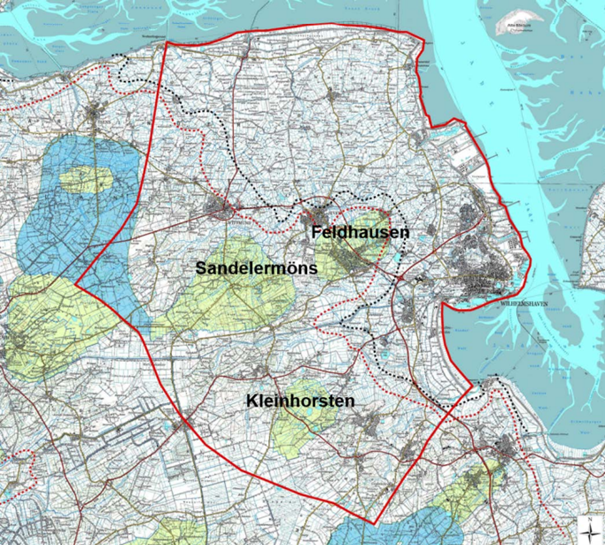
Water: a precious commodity – tool developed for sustainable drinking water management
Only 3 per cent of the water on our planet is fresh water and again, only a small part of it can be used as drinking water. In times of climate change, water resources are not only becoming scarce in arid regions. Coastal regions, for example, are also facing this challenge, where water is available in abundance but is partly unsuitable for consumption or irrigation.
On the coast, there may also be factors that exacerbate the problem, such as an increase in tourism, a comparatively high population density or agriculture. It becomes problematic when climate change and the resulting rising sea level cause seawater to penetrate into the groundwater-bearing strata, thus rendering drinking water resources unusable. Accordingly, forward-looking and sustainable management of drinking water resources is important, especially also in coastal regions.
NAWAK 2.0: How do climate change and demographic development influence the availability of drinking water?
GRS has been working on the topic of drinking water for almost ten years. For example, a research team investigated the influence of climate change and demographic development on the availability of drinking water in the joint project NAWAK - at that time, the focus was on an area in the coastal region of northern Germany. This was followed by the go-CAM project funded by the Federal Ministry of Education and Research, which was carried out together with the TU Braunschweig, the Oldenburgisch-Ostfriesischer Wasserverband (OOWV) and other project partners.
In addition, they further developed the methods developed in the previous project in order to be able to forecast the influence of different scenarios on the availability of drinking water.
Drinking water availability: forecast up to the year 2100
The aim was to forecast water availability up to the year 2100. Since a variety of factors influence the availability of drinking water, the scientists first derived different scenarios from these factors. The scenarios can be divided into two different groups: Climate scenarios and demand scenarios.
Of course, the former include in particular the impacts of climate change, such as sea-level rise, and changes in groundwater recharge, which can reduce the availability of drinking water. They varied groundwater recharge and sea-level rise based on the climate scenarios provided by the Intergovernmental Panel on Climate Change (IPCC). For example, they considered values for the scenarios between half a metre and one metre for the assumed rise in sea level by 2100.
Climate scenarios and demand scenarios
The demand scenarios include regional economic and demographic developments, but also possible competing uses between the various public water suppliers, industry and agriculture. For example, the project partner OOWV expects that in the future it will also have to supply neighbouring regions from one of its waterworks that are already experiencing supply bottlenecks. Due to the different scenarios, a range of possible outcomes could thus be calculated.
In order to be able to carry out the forecasts, a number of work steps were necessary: as a first step, hydrological and hydrogeological models had to be developed. These models become particularly complex when, for example, the penetration of seawater into the groundwater is taken into account.
GRS simulation code from repository safety research was used
To create these models, the researchers used the simulation code d3f++. GRS and its partners originally developed this code to calculate the groundwater flow and the transport of radionuclides in the overburden of a repository for radioactive waste. With the simulation code, it was then also possible to adapt the complex modelling of groundwater dynamics with seawater influence to larger areas (> 1,000 km2) as well as long assessment periods of several decades.
After the researchers had created, calibrated and tested the groundwater models, they were able to feed the models with the values from the various climate and demand scenarios and carry out the corresponding simulations. Then, they derived the most descriptive indicators possible from the three-dimensional, time-dependent results. These indicators include groundwater levels, salinity and the available water volume for different forecast periods.
Use in practice: decision-making basis for sustainable groundwater management
Finally, these indicators were fed into the so-called MCDA tool "CAM". MCDA stands for “multi criteria decision analysis”, CAM for “coastal aquifer management”. With the help of this tool, decision-makers in authorities or companies can define criteria for sustainable groundwater management.
On the one hand, they have information and assessments of the current state of water resources at their disposal and, on the other hand, they can evaluate different scenarios on the basis of self-defined target functions. This allows risks to be identified earlier and possible measures to be drawn up and assessed in line with the UN’s Sustainable Development Goals.
Drinking water standard in the areas investigated stable until the year 2100
In summary, the situation regarding the drinking water standard (chloride content 250 mg/l) for the investigated areas in northern and north-western Germany remains stable across all simulated scenarios until the year 2100. In order to increase the level of detail of the models and thus their predictive accuracy, the researchers recommend collecting further data in the areas investigated.
The research project was funded by the Federal Ministry of Education and Research. The final report is publicly available in the GRS publications database.
